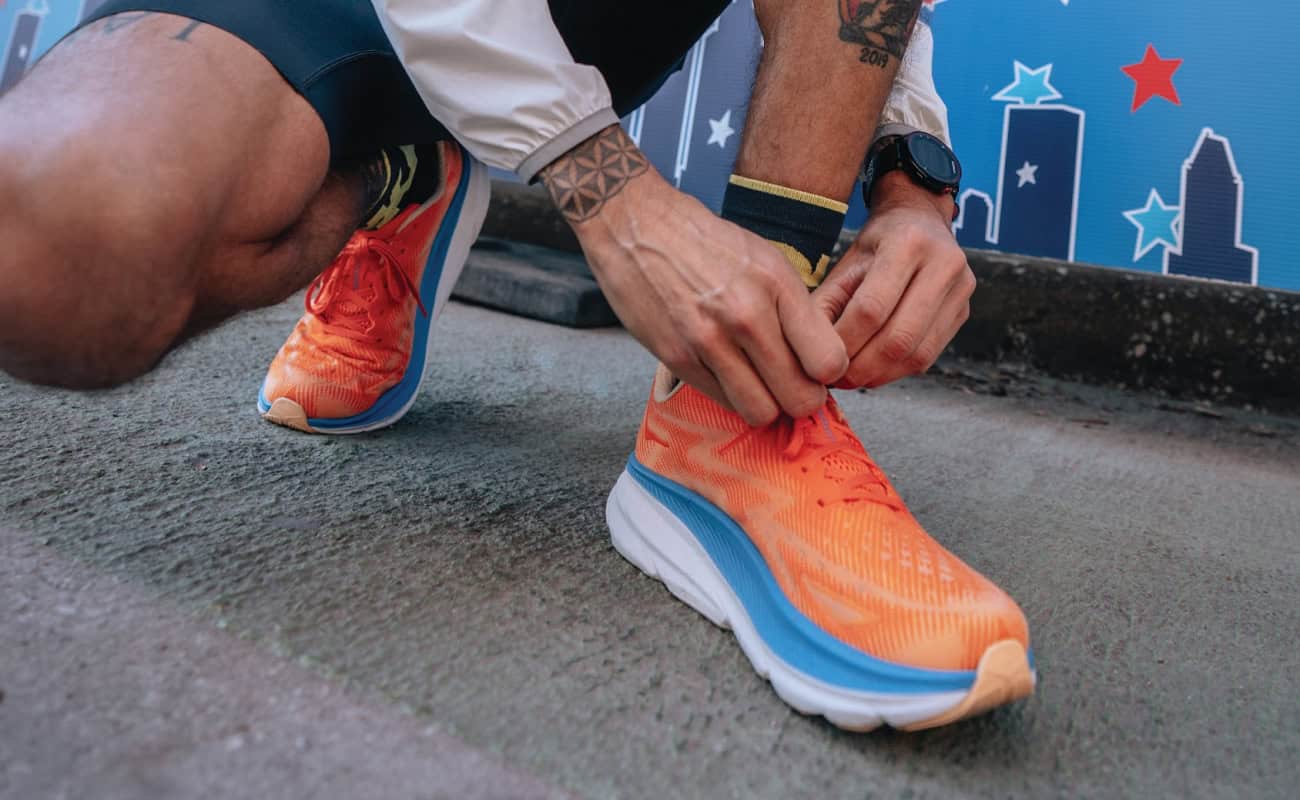For all of winter’s dazzling beauty, there’s something sinister about it. Yes, that fluffy, festive season is a special kind of bummer for runaholics. Friends might say Why don’t you just join a gym? Maybe they’ll even advise you to “take up indoor sports.” But they don’t get it—not really. For you, nothing can replace the simple elegance and steady rhythm of a good ol’ run.
But this year is going to be different. Because this is the year you take running back from winter.
We present you with the complete guide to cold weather running. By the end of this article, you’ll have all the requisite know-how to make running a year-round activity. With a few simple tips, the right gear, and a little bit of grit (OK…maybe a lot of grit), even a novice runner can start crushing clicks through the dead of Feb.
Is it Safe to Run During Winter?
In many ways, winter running is no more dangerous than your typical summertime run. As we’ll see below this can be boiled down to proper equipment, knowledge of your route/terrain, and acute common sense. With these bases covered, you can effectively minimize the probability of injury.
Old Wives’ Tale or Scientific Fact?
Remember that old line you’d hear growing up? Something like, “Don’t go outside when it’s cold or you’ll get sick!” It’s interesting to note that recent findings suggest quite the opposite—well, sort of.
Researchers induced mild shivering in a sample of runners and measured their norepinephrine levels (the fight-or-flight neurotransmitter more affectionately known as adrenaline). They discovered that the increase in norepinephrine contributed to an increased immune-response.
The jury is still out on whether moderate to high levels of shivering could induce a similar reaction (likely not), but the takeaway is this: As long as you’re well dressed for the weather, exercising responsibly in cold climates can actually boost your immune system’s resilience to pesky pathogens.

Winter Running & Weight Loss
According to Dr. Dominique Gagnon’s research, getting out for a winter run causes your body to burn fat instead of muscle glycogen. Not only will this help you shed weight, but you’ll be guarding your muscles’ limited energy stores until you really need them.
The Sunshine Vitamin
It’s estimated that roughly 40% of Canadians are Vitamin D deficient during winter. Besides supplementing your diet with foods containing high levels of vitamin D, there’s something else you can do.
While most people are happy to Netflix and chill till spring, you’re not most people. So whenever possible choose a sunny day for your cold weather running. You’ll benefit by increasing your internal vitamin D production.
This occurs when UVB light from the sun stimulates cholesterol in the skin, which kicks off a cascade that results in the endogenous production of vitamin D3. Our bodies use two forms of vitamin D: D2 and D3, but either will do and both are essential for healthy bones.
Since it doesn’t take long to get your daily fill of vitamin D, you don’t need to rely on tanning beds. (For those who do, remember that excessive amounts of UVB can lead to melanoma and other skin conditions.)
Curing the Winter Blues
Another benefit of winter running is that it helps reduce the impact of Seasonal Affective Disorder (SAD). This is thanks to the burst of endorphins that shower your brain in good vibes.
Like analgesics, endorphins are known to reduce sensitivity to pain both physically and emotionally. They also work as a sort of endogenous sedative to reduce anxiety, lower blood pressure, improve sleep, and much more.
Of course, any physical activity will trigger endorphin release to some extent. So if winter running isn’t your thing, don’t worry—you can always hit the treadmill!
Blame the Humidity
If you suffer from chronic joint issues or recurring injuries, check the humidity level before setting off for a cold weather run. As it turns out, temperature isn’t the variable responsible for those painful flare-ups in your knee or back—it’s the humidity.
Instead of giving up on winter running altogether, try to schedule your runs in dry, low-humidity conditions.
Common Sense
Winter running demands extra planning and precautions. There’s the obvious stuff (like not practising those 30-degree inclines on black ice), and then there are the grey zones.
When it comes to grey zone decisions, our tendency is to lean towards the thing we want. But as a practiced devotee to common sense, you won’t be so easily fooled. As evidenced by countless outdoor tragedies, lives could have been saved by simply recognizing hubris. In hand-to-hand combat, mother nature will beat you every time.
Make it a rule: if running falls into a safety grey zone—just wait. Perhaps the wind is gusting slightly harder than usual, or the temperature is quickly dropping, or visibility is unusually low. Maybe your weather app even promised a major snowstorm that still hasn’t hit…
Having a mental flowchart before situations like these arise will enable you to better resist the urge for immediate gratification.
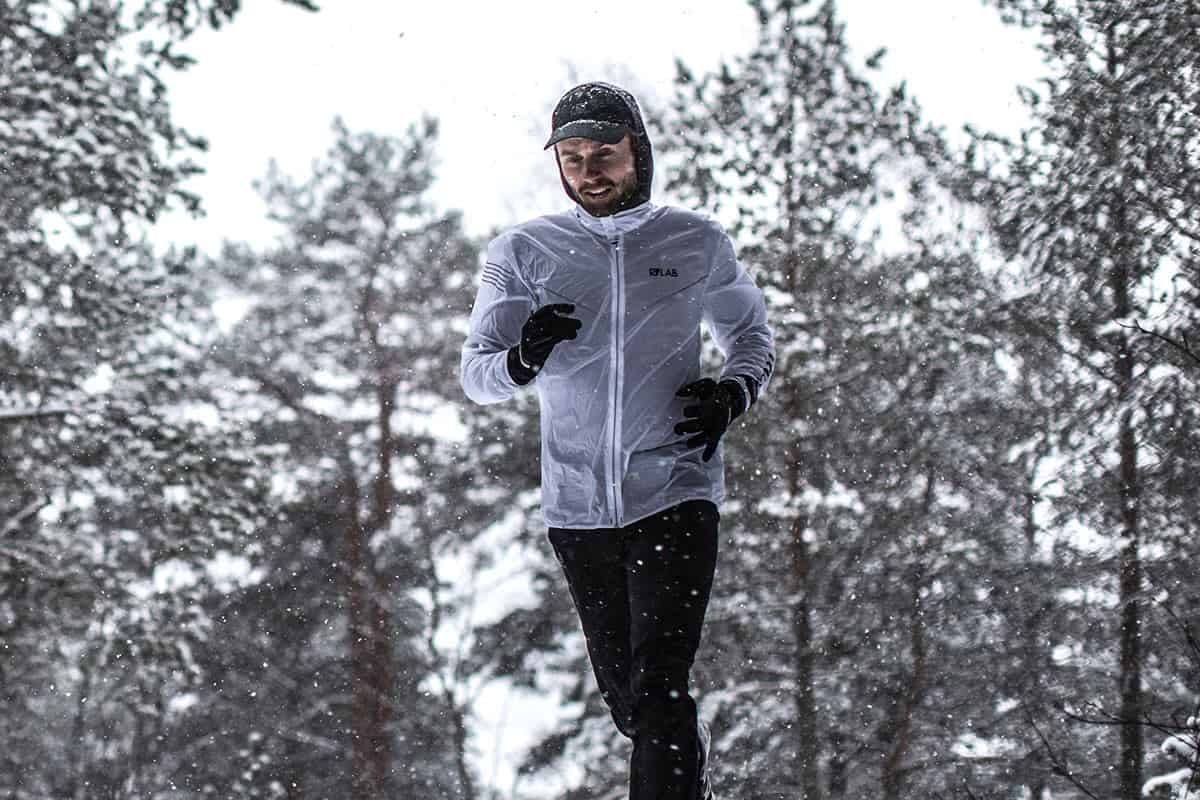
How Cold is Too Cold to Run
It’s easy to make the mistake of underestimating how cold it is outside—especially on bright, sunny days. If you’re a veteran of northern winters, you know exactly what I’m talking about.
While adding layers can help up to a point, there’s a clear temperature line below which you should definitely postpone your run. According to Dr. Natalie Markland, if the mercury dips below -28°C (-20 F)—don’t run! Under these conditions, it only takes half an hour before frostbite begins.
Make it a habit to check the forecast before you leave home.
Breathing Issues? Be Extra Careful
If you suffer from a preexisting breathing condition like asthma, it may be best to avoid cold weather running altogether. Even for those with healthy lungs, the air temperature and dryness can cause a burning sensation in your throat and chest, placing undue stress on your immune system.
The Staying-Put Paradox
We can’t all be like David Goggins (but if you are, feel free to skim through the rest of this article). If conditions seem questionable, be ready to postpone your run.
While you may experience a pang of guilt in the moment, you’re actually making a long-term investment. Being mindful of your safety means a lower risk of injury. And a lower risk of injury means a higher kilometre count by the time the flowers bloom.

How to Run During Winter
Below we cover proper technique, mindset, and a few tips to help you get started.
Stay Vigilant
It only takes a soft gust of wind to create a fine layer of snow over your path. This can conceal dangerous patches of black ice, even for a focused runner. Stay vigilant and take your time; your new 10km P.B. can wait till next summer.
Stretch
By its very nature, cold weather running demands that we take our time. Our muscles and tendons simply can’t warm up as quickly and robustly in cold weather, which increases the risk of pulling something.
To prepare for a winter run, do some dynamic stretching. Not only will this oxygenate your muscles but it’ll make your body limber. Having a relaxed body will enable you to react better to sudden slips. As Bruce Lee would say, be water, my friend.
Float like a Butterfly
In order to run as safely as possible, it’s essential to adapt your running style to icy and snowy terrain. Long strides mean your legs will be landing beyond your body’s natural center of gravity, making it more difficult to recover from a slip.
Instead, increase the cadence of your steps (the number of steps you take per minute), while decreasing the amplitude of your stride (the distance between your feet). You’ll also want to reduce the contact time of each step; keep them brief and light, as though the force of gravity has weakened. To improve balance, keep your hands around waist level.
Stabilizers & Proprioception
Whether soft or firm, travelling over convoluted surfaces can be an excellent exercise—and not just for your heart and legs. Winter running is a great proprioception workout.
Proprioception is the ability to accurately perceive your position and orientation in space. In response to the undulations and low traction of wintery terrain, your proprioception will activate stabilizer muscles throughout your body to keep you aligned on the right axis.
Eat Enough
Just because you’re not crushing speed records, doesn’t mean your body isn’t getting a killer workout. In fact, running on snow requires 1.5 – 2 times more energy to complete the same distance in warm weather. This is something you should consider when planning your meals leading up to a run.
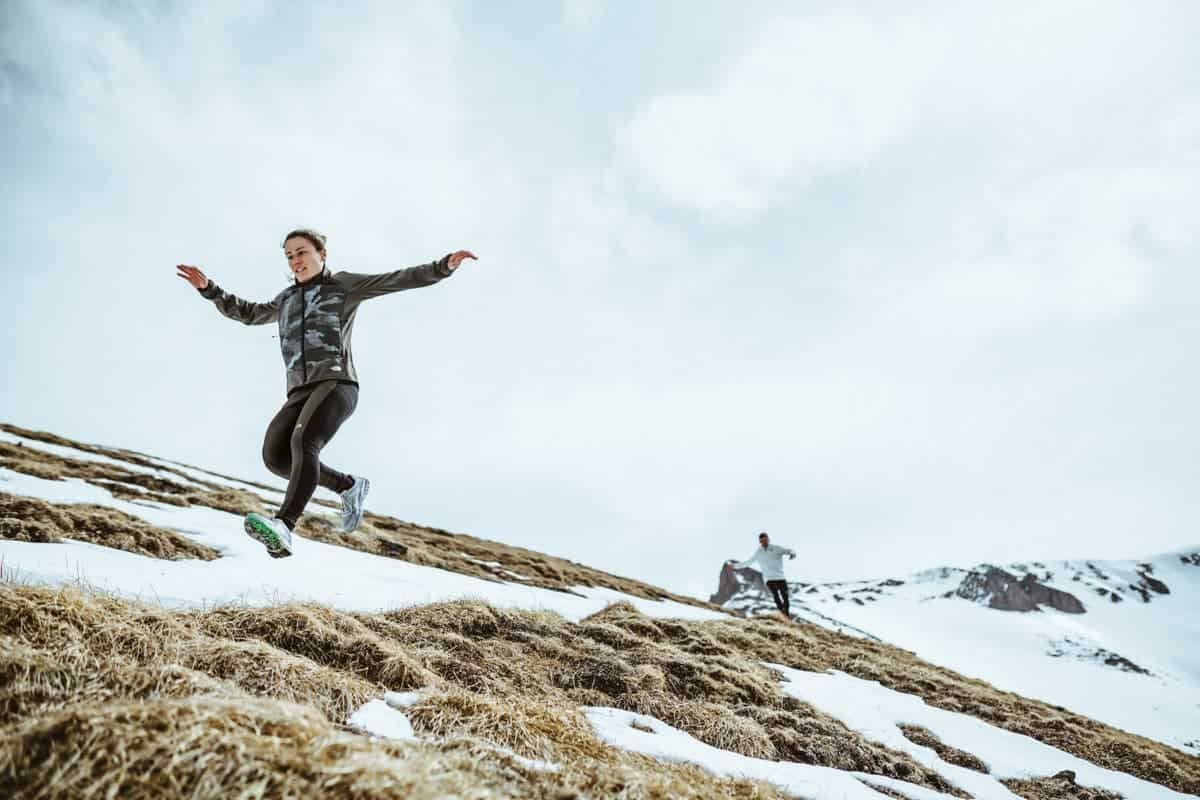
Never Stop Moving
Minimize breaks during a run, as your body heat will quickly radiate out into the cold. If you do need to stop, try and maintain some movement to generate heat, like jogging in place or rubbing your hands together.
Thou Shalt Not Wear Cotton
You probably already know this, but it’s as true with winter running as it is with summer running. Cotton is simply a terrible insulator. It retains—rather than wicks—water, and becomes heavy when wet (in fact, up to 27 times heavier!). Not to mention cotton is a one-way ticket to Nipple Chafe City.
Instead, choose moisture-wicking layers that will not only keep you insulated but dry. A sweaty non-wicking baselayer—no matter how warm it is—is a surefire route to hypothermia. You’ll find more on what to wear below.
The Secret is Layering
This has two advantages for cold weather running. The first is that if you begin to overheat you can shed a layer without sacrificing your only piece of warm clothing. The second advantage is that layering actually keeps you toastier by creating warm air pockets between each layer.
Dress as though it were 10°C warmer. Your body is going to overheat quickly if you dress for the actual temperature. And yes, this means you can expect to feel a little chilly at the beginning of your run.
Mind the Extremities
You’ve probably heard that up to 45% of our body heat escapes through your head. As it turns out—this is bullpits. In fact, we lose as much heat through our head as through any other part of our body. It’s just that our face, head, and ears tend to be more sensitive to changes in temperature.
If your well-bundled extremities (hands, feet, and head) begin to get cold during a run, it may not be due to heat escaping outward, but that your body is actually mobilizing heat inwards. When your core temperature starts to drop, your brain marshals blood away from your extremities and directs it towards the core to protect the vital organs.
So next time you’ve got cold hands, notice whether your core is properly insulated before reaching for another pair of gloves. All that said, your extremities are more susceptible to frostbite—pay special attention to protecting your fingers, toes, ears and nose from sharp winds.
Cool Down with Static Stretching
By engaging so many muscles throughout your body, winter running can put strain on areas that aren’t used to exertion. It’s easy to underestimate the toll this can take on those areas over time.
That’s why you should always add a little post-run stretching routine. Use static stretches and make it full-body. You can even incorporate a foam roller into the mix to relieve those deep tissue tensions.

Know Your Terrain
There are two main terrain types you should be familiar with when considering cold weather running.
Pavement
While sidewalks can certainly gather a few feet of snow, you usually won’t have to wait long before they’re cleared. But just because you have a level running surface, doesn’t mean it’s without any danger.
The risk associated with running on pavement during winter is black ice. As the name implies, black ice isn’t always easy to spot. When in doubt, slow down. Make sure to use proper winter running form (covered above) to keep your body as balanced as possible. A pair of running shoes with a studded sole is a must. More on that below.
Trail Running
When it comes to winter trail running, be prepared to encounter every gradation of ice and snow. If you’re nervous, consider pairing your shoes with a set of microspikes. Microspikes are a simple after-market device that attach easily to your shoe and feature a pattern of metal spikes on the sole for extra traction.
Dealing with ice and snow
Don’t let ice and snow slip you up this winter! The right technique coupled with the proper shoe will reduce the dangers associated with slippery surfaces. Use your eyes to scan the path ahead. And remember to take your time—winter running is about enjoying the journey, not breaking personal records!
What to Wear For Cold Weather Running
While experience is the only method for developing the necessary technique and mindset, there is one thing you can nail from the get-go: your gear.
It’s a bit of a tightrope: you need to be able to maintain your body temperature without overheating. The trick is to experiment with short-distances and track how well your body maintains its temperature.
Here’s a tip: Keep a log of what you wore, the temperature/humidity, and your speed and distance. If you’re a bit of a running geek, you can also note the wind speed. In no time at all, you’ll have established a dress code to keep you comfortable in any temperature.

Fabrics
Merino
Merino is a type of sheep’s wool and is one of nature’s most efficient insulators. Merino is harvested every year in the summertime in a process that’s both humane and sustainable. In fact, a single sheep can produce between three and five pounds of merino wool per year.
The fibers themselves have evolved to withstand an impressive range of conditions. The front-facing part of the fiber is crimped, which allows it to trap heat, while the inside-facing part of the fiber is straight, which wicks water vapour from your skin.
Because of its design, merino works just as well in a July heatwave as during a January squall.
Polyester
Polyester is a catch-all term for any man-made fabric containing polyethylene terephthalate (PET), a material derived from plastic. Common across all fibers in this category is a high propensity to stand up to wind and water. Many polyester garments are also very durable, flame-retardant, and wrinkle-proof.
Some well-known, high-quality polyesters include:
- Capilene: This is Patagonia’s in-house polyester. It’s used to make their line of baselayer tops and bottoms, which come in a variety of weights. The fabric is known for its excellent warmth-to-weight ratio. Capilene also wicks efficiently, dries fast, and controls odours (thanks to the Polygiene in the weave). In general, it is considered lighter and faster-drying than merino.
- Thermal Pro: Created by the polar fleece company, Polartec, Thermal Pro is the brand’s leading technical fleece that claims to deliver the same warmth and comfort as wool. Interestingly, though the word fleece refers to a sheep’s natural coat, all fleece products are actually made from polyester.
To learn more about the fascinating and functional differences between some leading fabrics, check out, Fleece VS Down VS Merino Wool—The Ultimate Midlayer Face-Off.
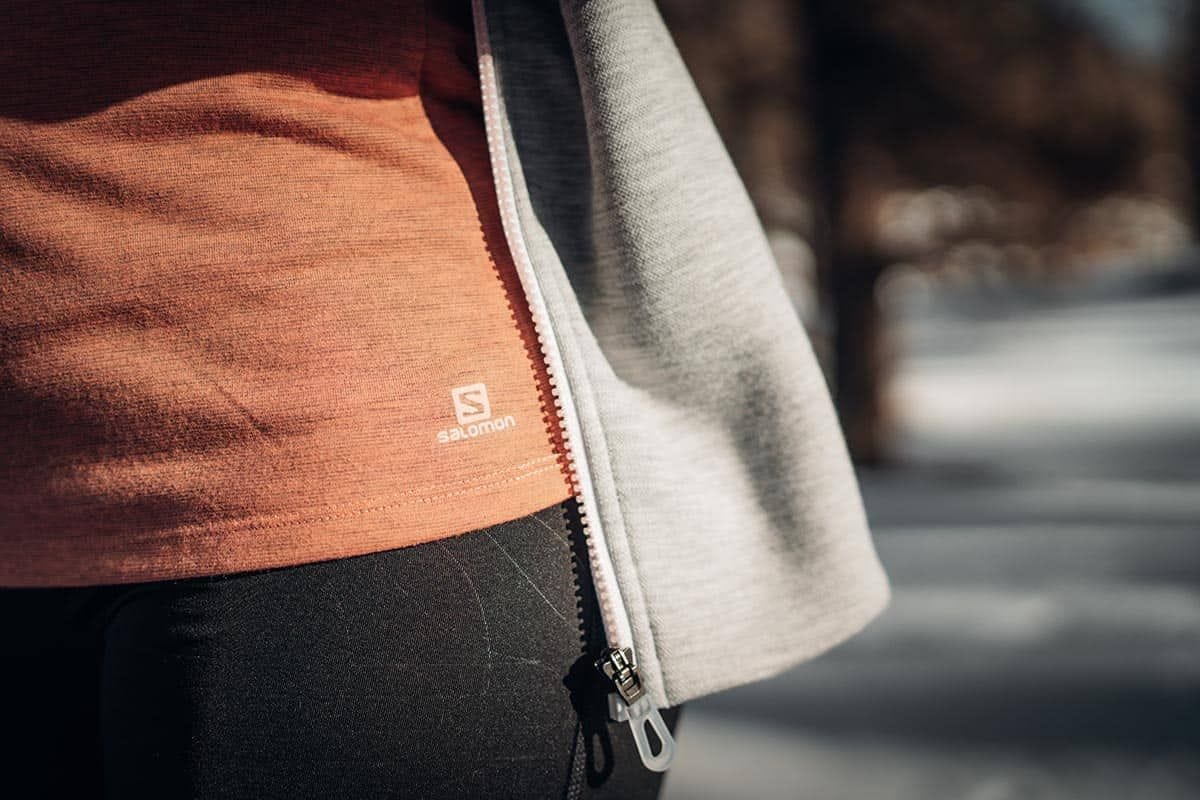
Base layer
A base layer is any garment that’s made to sit next-to-skin. They are typically made from a lightweight material that fits snug—polyester or Merino, but never cotton.
Any base layer worth its salt will feature moisture-wicking properties, and are often infused with some sort of odour-blocking fibre.
Base layers come in both tops and bottoms. On warm winter days, you can often get away with just rocking base layers for your run.
- Lorem ipsum dolor<\/li>
- Lorem ipsum dolor<\/li>
- Lorem ipsum dolor<\/li><\/ul>","_id":"c3ab185"},{"feature":"
- Lorem ipsum dolor<\/li>
- Lorem ipsum dolor<\/li>
- Lorem ipsum dolor<\/li><\/ul>","_id":"5a897e6"}],"single_product_id":null,"cta_1_url":null,"cta_2_url":null,"credit":null,"limit":4,"collection_link":"https:\/\/www.altitude-sports.com\/collections\/women-base-layers-tops"}
Mid layer
As the name implies, mid layers make up the center of the layering hierarchy. Their raison d’être is to keep you well-insulated beyond the capacity of a mere base layer. They’re usually snug, but not nearly as snug as a base layer. This allows you to throw something over top without becoming constricted, while still effectively trapping warm air.
Mid layers can vary depending on the insulation you need. On warmer days, a lightweight fleece is perfect; on colder days, you might opt for a puffy insulated jacket.
For everything you ever wanted to know about layering check out our in-depth guide, How to Layer for Outdoor Activities.
Jackets & Shells
The barrier that takes the brunt of the elements is your jacket, or shell. There are two types of shells: softshells and hardshells. The former category refers to jackets which both insulate and offer some degree of cold weather running weather-resistance. The latter category is solely weather-resistant.
At first glance, it seems like softshells are twice as useful as hardshells, but in fact their level of weather-resistance is diminished by their insulating properties. Hardshells, on the other hand, are typically made of a breathable, waterproof lining like Gore Tex Pro. Hardshells are especially nice for their lightweight build, which won’t hold you back while cold weather running.
Both types of shells have their pros and cons depending on weather conditions. In a blustering storm, a hardshell works well to protect against biting winds; paired with an insulating midlayer, this is an unbeatable combination. Alternatively, frigid days with neither wind nor precipitation might be better suited to a softshell for some extra degrees of warmth.
For more information, check out our favorite winter running jackets.
- Lorem ipsum dolor<\/li>
- Lorem ipsum dolor<\/li>
- Lorem ipsum dolor<\/li><\/ul>","_id":"982e51f"},{"feature":"
- Lorem ipsum dolor<\/li>
- Lorem ipsum dolor<\/li>
- Lorem ipsum dolor<\/li><\/ul>","_id":"74d44ab"}],"single_product_id":null,"cta_1_url":null,"cta_2_url":null,"credit":null,"limit":null,"collection_link":null}
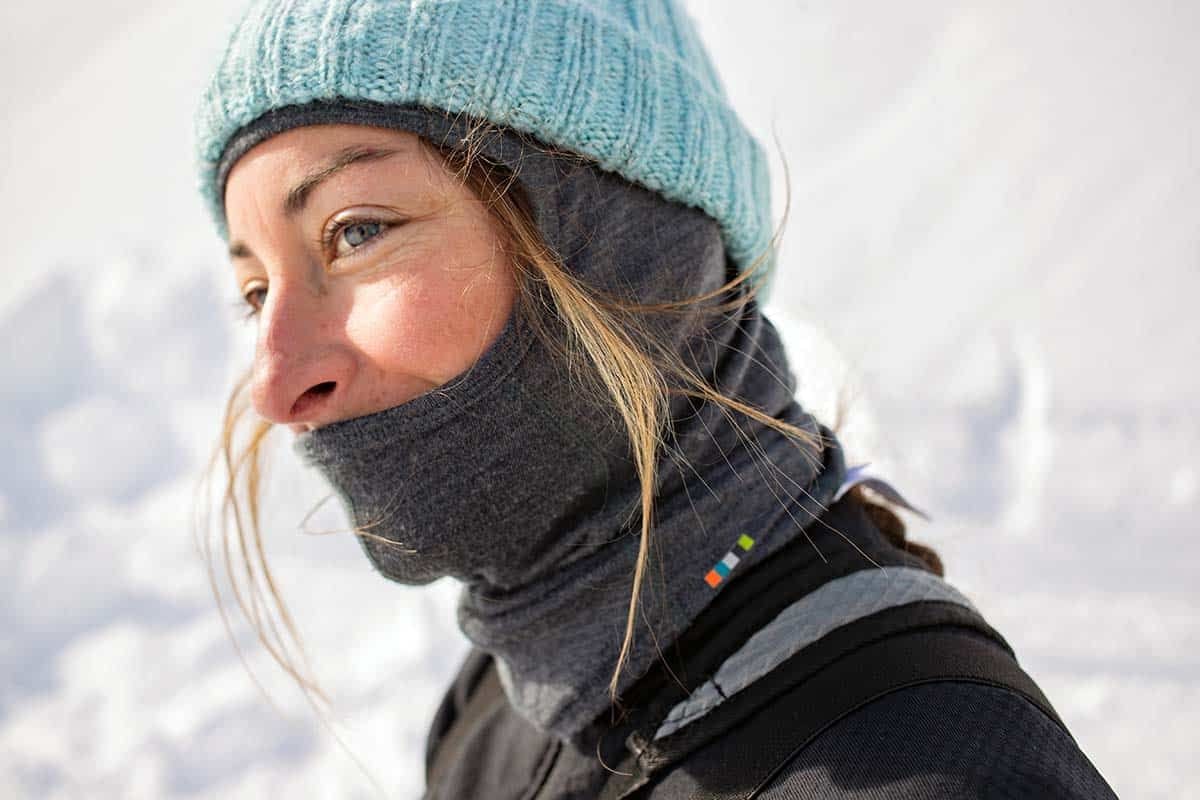
Tights & Pants
As baselayers, tights offer next-to-skin comfort. They should be insulating, breathable, and water-wicking. Tights often contain some percentage of elastane (such as Spandex), which allow them to be flexible and non-constricting.
On especially chilly days, pants can go over top a pair of tights to increase weather-resistance and insulation. For more information, check out our picks for the best winter running bottoms.
- Lorem ipsum dolor<\/li>
- Lorem ipsum dolor<\/li>
- Lorem ipsum dolor<\/li><\/ul>","_id":"183128f"},{"feature":"
- Lorem ipsum dolor<\/li>
- Lorem ipsum dolor<\/li>
- Lorem ipsum dolor<\/li><\/ul>","_id":"405365a"}],"single_product_id":null,"cta_1_url":null,"cta_2_url":null,"credit":null,"limit":null,"collection_link":null}
Underwear
This may seem obvious, but many people make the mistake of wearing cotton underwear on their winter run. It’s hard to stress this enough: cotton is a horrible insulator, a dismal wicker, and a lousy fabric for any serious activity!
For men, brands like SAXX and BN3TH offer comfortable synthetic boxers with um… full-support. For both male and female merino fans, Icebreaker and SmartWool have some amazingly soft and versatile options for athletic pursuits.
Socks
Many runners love the minimalism of low-cut socks. But in winter you’ll want to swap them out for a quarter length or crew sock instead. To help keep your feet dry, make sure to use a wicking sock; wet feet can lead to frostbite and painful blisters.
Again, just say no to cotton! Merino or synthetics are essential. In addition to SmartWool, Darn Tough offers an incredible range of merino-blend socks; they’re made in the U.S.A and have a stellar warranty.
You can also layer your socks for added insulation; use a synthetic sock liner first and couple that with a thicker insulating sock. The trick is to ensure you still leave a little room between the tips of your toes and the front of your shoe.
This empty space traps warm air and helps keep your feet nice and toasty. By overlayering, you’ll end up with a tight-fitting sneaker. This is both uncomfortable and will actually result in cold feet, since there’s no space for warm air to circulate.
Head & Neck
As we learned earlier, heat doesn’t preferentially escape through the head. Still, it’s important to keep your head warm—your ears and nose are prime candidates for frostbite.
In general, you’ll want a hat that’s lightweight and breathable. Your hair (if you have some) is a natural insulator. Therefore, except on really cold days, an ultralight tuque that repels wind and water will suffice.
To protect your neck and cheeks, buffs are our winter running favourite. Their versatility is unmatched; you can use yours as a scarf or fashion it into a balaclava. Check out its many variations here.
Gloves & Mitts
Like your toes, ears, and cheeks, your fingertips are at the front lines of frostbite. For most cold weather running conditions, however, you don’t need much more than an insulating, weather-resistant glove liner.
While gloves offer a greater tactile range, the extra space created by a mitts between your fingers allows for warm air to circulate. If you’re someone whose hands tend to stay cold no matter what, try layering: a warm, wool mitt can be placed over a thin glove liner for superior insulation.
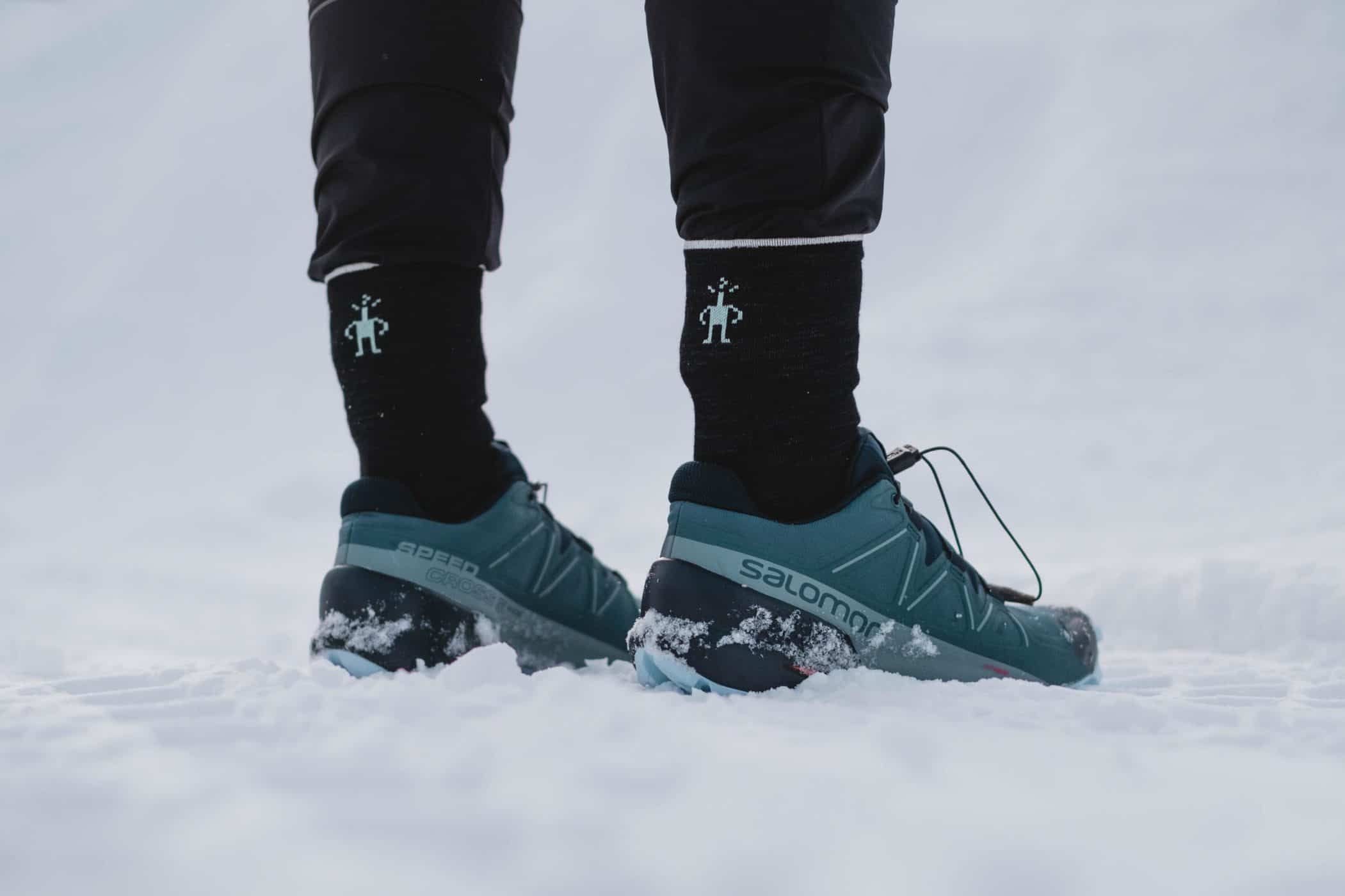
Use Proper Footwear
Winter running footwear has come a long way. Most of today’s models are designed to be less bulky and less heavy, while being more waterproof and more breathable than their predecessors.
Something with a studded sole is recommended, as it can help prevent sprains and other injuries. The added traction keeps your foot aligned beneath your knee. This avoids putting undue strain on your lateral ankle ligaments as your foot tries to grab the ground.
If you try on a pair of winter running shoes in person, make sure to wear the same socks you intend to wear during your run. Some folks find they have to size up in order to fit their thicker sock, or combination of socks. For the best options in 2024, check out our favourite winter running shoes.
- Lorem ipsum dolor<\/li>
- Lorem ipsum dolor<\/li>
- Lorem ipsum dolor<\/li><\/ul>","_id":"16c57e8"},{"feature":"
- Lorem ipsum dolor<\/li>
- Lorem ipsum dolor<\/li>
- Lorem ipsum dolor<\/li><\/ul>","_id":"4ea9b8c"}],"single_product_id":null,"cta_1_url":null,"cta_2_url":null,"credit":null,"limit":null,"collection_link":null}
Uppers
The upper of a shoe refers to everything above the sole. For winter running, you’ll want an upper that’s both breathable and waterproof. Breathability prevents sweat from accumulating in your shoe, while waterproofing prevents puddles and precipitation from entering your shoe.
Basically, a good upper should keep your feet dry from both the inside and outside. Look out for waterproof materials like GORE-TEX (GTX), as this offers a good amount of breathability.
Soles & Traction
When choosing a winter running shoe, go for something with lugs. Lugs protrude from the sole in patterns that optimize traction. Better traction means you can move more quickly through the terrain while minimizing the chance of injury. In particular, you’ll glide better over soft and uneven surfaces, while gripping into icy surfaces.
Should I Use Waterproof Shoes?
Consider the kinds of terrain you’ll likely encounter when cold weather running: chances are, you’ll be making a few beelines through icy puddles and ankle-deep snow. Not only will a waterproof shoe keep your feet dry, they’ll keep your feet warm. A ceaseless barrage of cold water, snow, and ice will quickly numb your feet and may even lead to frostbite.
So yes—use a waterproof shoe. You won’t regret it.

Hydration
Even experienced runners forget to stay hydrated in cold weather. But dehydration can strike as hard in sub-zero temperatures as it can on the 4th of July. It’s recommended that you drink enough water throughout the day before starting your run to avoid dehydration.
Alternatively, you can carry a water bottle or two on a fuel belt. Make sure the water is between 10 – 22 °C (50 – 72 F). This is the optimal temperature range for water absorption. In this range, you’ll rehydrate quickly and effectively without shocking your body.
If the water on your fuel belt becomes chilled, take small sips and let the water sit in your mouth for a few seconds. This will allow you to warm it up before swallowing.
conclusion
Many people believe that cold weather running is a sport reserved for the most elite (and perhaps most insane) runners. But as we’ve seen, that simply isn’t true.
While winter running does require some determination to get going, it’s ultimately about the right gear, good technique, and a little common sense.
For beginners, just remember to take it slow at first. Taking the time to prepare is time well spent: Check the weather, plan your outfit, and know your route. Having a contingency plan if something goes wrong is essential—keep your phone with you and let someone know where you’re going and how long you plan to be gone. And, of course, stay hydrated.
With that, I wish you an epic season of cold weather running!



























